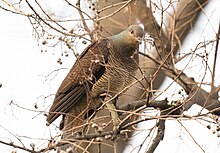| Barred cuckoo-dove | |
|---|---|

| |
| Conservation status | |
 Least Concern (IUCN 3.1) | |
| Scientific classification | |
| Domain: | Eukaryota |
| Kingdom: | Animalia |
| Phylum: | Chordata |
| Class: | Aves |
| Order: | Columbiformes |
| Family: | Columbidae |
| Genus: | Macropygia |
| Species: | M. unchall |
| Binomial name | |
| Macropygia unchall (Wagler, 1827) | |
The barred cuckoo-dove (Macropygia unchall) is a bird species in the family Columbidae. It is native to South and Southeast Asia, and listed as Least Concern on the IUCN Red List.
Taxonomy

German herpetologist Johann Georg Wagler first described the barred cuckoo-dove in 1827. It has three recognized subspecies:
- M. u. tusalia (Blyth, 1843)
- M. u. minor (Swinhoe, 1870)
- M. u. unchall (Wagler, 1827)
Description

The barred cuckoo-dove has a buff coloured throat and forehead which becomes pinkish grey at the crown. measures 37 to 41 cm (15 to 16 in) in length, and weighs 153 to 182 g (5.4 to 6.4 oz). Its iris is yellow or pale brown, the beak is black and short, and the feet are red. It has blackish brown upperparts. The back, mantle (between the nape and the starting of the back), rump, wing coverts, and scapulars have reddish brown fringes. The tail is blackish brown, and is heavily barred reddish brown.
It is similar to the little cuckoo-dove, but it is much larger and darker, and is black-barred on the mantle, breast, coverts, and tail.
Distribution and habitat
The barred cuckoo-dove occurs from the Himalayas to Southeast Asia. It inhabits dense subtropical woodlands at altitudes of 800 to 3,000 m (2,600 to 9,800 ft) from sea level, on montane slopes. It prefers clearings and edges of old-growth forests and second growth forests.
Behavior and ecology
The barred cuckoo-dove lives in small flocks. It has a loud kro-uum or u-va vocalization, in which the second note is louder than the first.
Status and conservation
Since 1998, the barred cuckoo-dove has been listed least concern on the IUCN Red List, because it has a large range—more than 20,000 km (7,700 mi) and the population trend is stable. Also, although its population numbers have not been determined, it is thought to comprise more than 10,000 individuals.
Local names
The Lepcha people of Sikkim call it ka ar fo.
References
- ^ BirdLife International (2016). "Macropygia unchall". IUCN Red List of Threatened Species. 2016: e.T22690545A93276810. doi:10.2305/IUCN.UK.2016-3.RLTS.T22690545A93276810.en. Retrieved 12 November 2021.
- Stuart Baker, E. C. (1913). "The Bar-tailed Cuckoo-dove". Indian pigeons and doves. London: Witherby & Co. pp. 238–243.
- ^ Baptista, L. F.; Trail, P. W.; Horblit, H. M.; Boesman, P. (2017). "Barred Cuckoo-dove (Macropygia unchall)". In del Hoyo, J.; Elliott, A.; Sargatal, J.; Christie, D. A.; de Juana, E. (eds.). Handbook of the Birds of the World Alive. Barcelona: Lynx Edicions. Retrieved 2017-09-20.
- ^ Brazil, M. (2009). "Pigeons and Doves III". Birds of East Asia. Eastern China, Taiwan, Korea, Japan and Eastern Russia. London: Christopher Helm. p. 248. ISBN 9780713670400.
- ^ MacKinnon, J. R.; Phillipps, K.; He, F. (2000). "Barred Cuckoo Dove Macropygia unchall". A Field Guide to the Birds of China. Oxford: Oxford University Press. pp. 133. ISBN 9780198549406.
- ^ Grewal, B.; Sen, S.; Singh, S.; Devasar, N.; Bhatia, G. (2017). A Photographic Field Guide to the Birds of India, Pakistan, Nepal, Bhutan, Sri Lanka, and Bangladesh (Paperback). Princeton, New Jersey: Princeton University Press. p. 224. ISBN 9780691176499.
- ^ Gibbs, D. (2010). Pigeons and Doves: A Guide to the Pigeons and Doves of the World. London: A & C Black, Bloomsbury Publishing. ISBN 9781408135556.
- Tamsang, K. P. (1980). The Lepcha-English Encyclopaedic Dictionary. Kalimpong: Mrs. Mayel Clymit Tamsang. p. 121.
External links
- "Barred cuckoo dove" (Audio) (Recording). Xeno canto.
- "Barred cuckoo-dove—Macropygia unchall". Encyclopedia of Life.
- Oriental Bird Images: Barred Cuckoo Dove Archived 2021-11-22 at the Wayback Machine Selected images